|
 Dwight Peck's personal website Dwight Peck's personal website
We flee South in the winter
Two weeks in Andalucia, December 2011
You may not find this terribly rewarding unless you're included here, so this is a good time for casual and random browsers to turn back before they get too caught up in the sweep and majesty of the proceedings and can't let go.
A brief three days in Sevilla

We're at the Hotel . . . well, as above. In the old town, a block from the river, about 20 minutes' walk from the Cathedral, not too expensive, and just a brief taxi ride down from the main Santa Justa train station on the Avenida Kansas City.

Not a very big room at all (understated), and the staff perhaps not as welcoming as we found at the chain's hotel in Córdoba, but it's beautifully done up. We're settled in now, and off for a walk on the river.

Riverside graffiti

Now for an afternoon in the Museo de Bellas Artes of Sevilla.
Backstory: Sevilla was founded by Hercules (we're told) and occupied successively by Neolithics, Tartessians, Greeks, Phoenicians and Carthaginians, Romans, Visigoths, Moors in the early 8th century -- and, after the caliphate, the greatest of the taifa kingdoms under al Mutamid in the 11th century, and then after the fervently dimwitted Moroccan Almoravids, a cultural heyday for Sevilla under the Moroccan Almohads who built the Giralda and original Alcázar -- then the Castilian Christians after 1248, and the Isla Mágica "no limit fun" amusement park since 1997. (That's the history in a nutshell.)

Established in a beautiful 17th century convent, the Seville Museum of Fine Arts has got tons of first-class stuff and roomsful of medieval and Renaissance, Murillo, Zurbarán, El Greco, and Ribera, and some Sevilla paintings from the 19th century that are not even religious.

Here's an inspiring tableau of the Last Supper of Christ and the Twelve Disciples dining on a rat. (In the famous Alonso Vazquez Last Supper, also in this museum, the rat's bigger.) (The sleeping diner is usually understood to be John the Evangelist, pace Dan Brown.)

Torregiano was a Florentine mercenary soldier who graduated to a kind of royal sculptor to Henry VIII and his friends in England, but was unruly and turned up in Sevilla doing desperate works like this Saint Jerome (St Hieronymus). He ended up dead in an Inquisition prison in 1528.

Christus triumphans (by Juan de las Roelas, ca. 1616)

Convent courtyards in the Museum of Fine Arts

Kristin preceding us to the Baroque rooms on the first floor

Very beautiful; it must have been fun to have been a nun here back in the old days.

-- Go in peace (by Zurbaràn)

"Ninja Saint"
(St Dominic, by Martínez Montañés)

Evidently the 19th and early 20th century Sevillan artists, the ones who weren't spending their days painting 20-metre epics on the tragic deaths of famous bullfighters (e.g., Villegas Cordero, La muerte del maestro), had a vigorous social conscience.
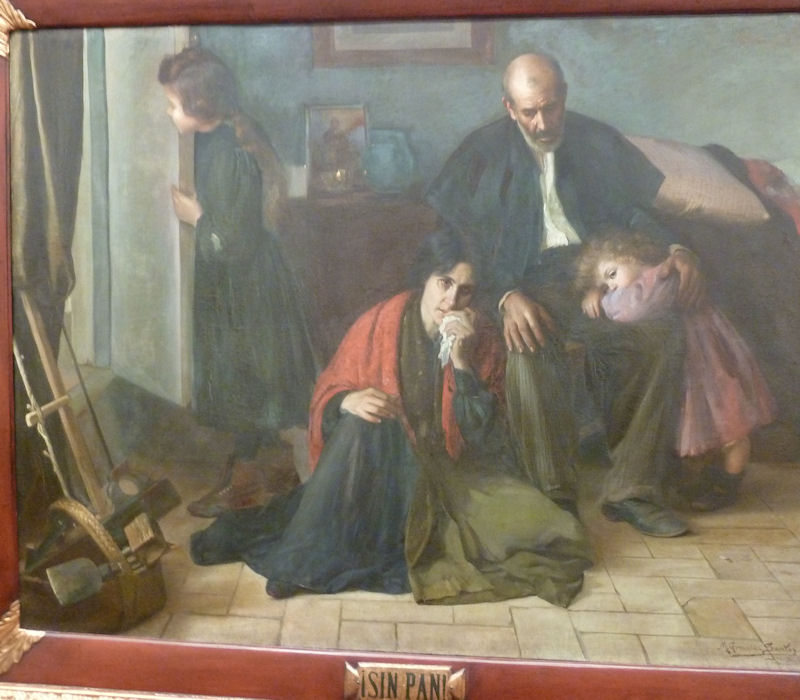
"No bread" (González Santos)

Kids

Back to the Eurostars Regina for a wash-up, then dinner in a little tapas diner near the Alameda de Hércules park

Next morning, 22 December 2011: Jesús of the Big Power (1620), in the Plaza de San Lorenzo

Jesús of the Gran Poder and . . .

. . . the Alhambra beer truck backing in for a bulk delivery.

Bootleg Roman mosaics in the Palacio de la Condesa de Lebrija

The Countess's staircase to the upper floors. The palace dates from the 15th century but was bought in 1901 by Mrs. Mergelina (the Countess of Lebrija), who reconstructed it in a mudéjar Renaissance style and furnished it with her huge collection of antiquities.

It's a fabulous place, filled with mosaic floors, tiles, statuary, trees, walls, all sorts of yellow things.

The disconcerting side of it is that evidently she owned the land upon which major Roman excavations were being made, and she seems to have hauled it all off here and cut it up to fit.
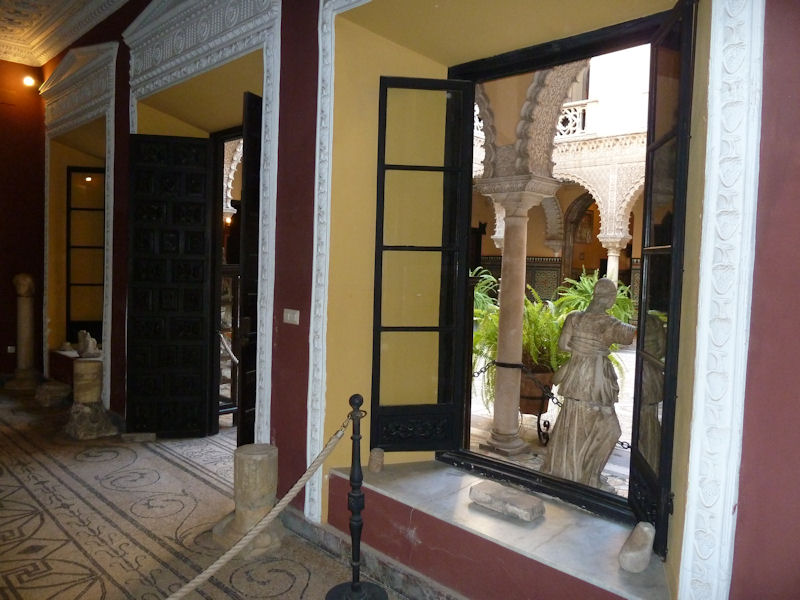
It is an excellent house, though, and worth the visit. She's got other stuff here, too, including a van Dyck, a Brueghel the Elder, and Murillo-school paintings.

You're allowed to wander all over the ground floor at will and then take the guided tour of many parts of the upper floor -- the good lady's descendants opened most of it to the public in 1999.

More Lebrija Palace photos. The place is right on one of the main little streets (Calle Cuna, parallel to the Calle Sierpes high street) on the way to the Cathedral.

And it can be hired for gala dinners, wedding receptions, lunches, boy scout jamborees, etc.

Chestnuts roasting by the open fire, and people relaxing on a morning lunch break in the Plaza del Salvador

Waiting patiently to be introduced

We're halfway between the Plaza del Salvador and the Cathedral now, but first . . .

We're passing the city hall, the Ayuntamiento, with a 16th century Plateresque 'silversmith' façade facing onto the Plaza de San Francisco. The famous pedestrian shopping street Calle Sierpes comes into the square directly opposite, just right of centre. Here's where our Christian forefathers got the tradition of the auto-da-fé off to a good start in 1481, burning heretics, Jews, Moslems, whomever, for their own good.
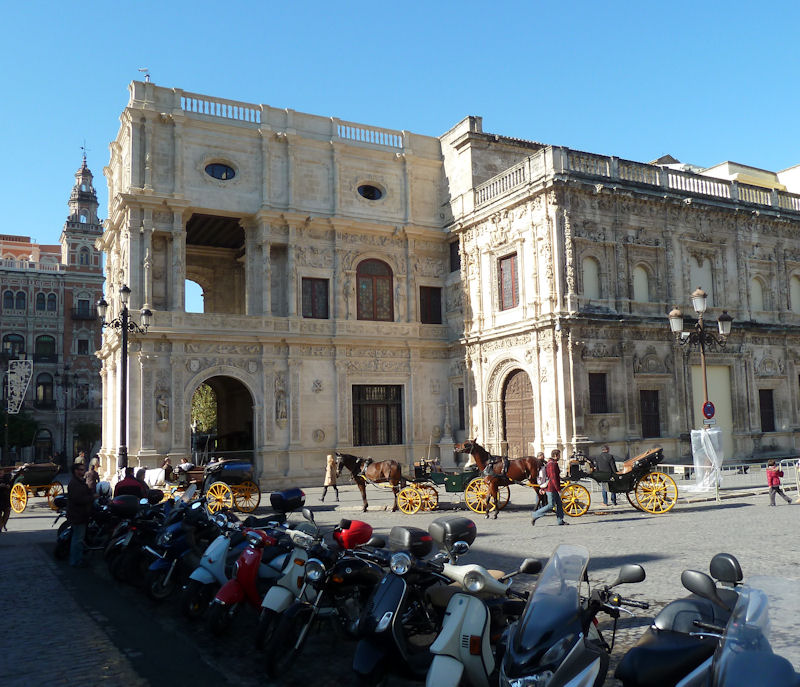
The city hall and some of the thousands of patient horses

Round the back of the Ayuntamiento, the Plaza Neuva, looking westward towards the river . . .

. . . and a tribute to our crusader Castilian king, Fernando III, "the Saint", who reconquisted Seville in 1248 and moved in.

The tramways on the Avenida de la Constitución looking towards the third largest cathedral in the world, whither we are wending.

The Giralda (icon of Sevilla) -- the 12th century minaret of the original mosque is now part of the great Cathedral ("the largest Gothic cathedral in the world")

The Puerta Catedral main gate (modern), leading into the Patio de los Naranjos (another Patio de los Naranjos!)

-- Well, can I at least give you my phone number?

The Cathedral interior. The mosque was redefined as a Christian church after the fall of the city in the mid-13th century, but then pulled down in 1401 (except for the Giralda) to make space for this one. The present edifice, though Gothic in style, was only completed in 1506 (and resumed in 1511 when the dome fell in).

-- I could be your best friend. Let me!

The huge interior has a huge number of chapels built round inside it, including a "royal chapel" that's the present home of Fernando III, "the Saint", his son Alfonso X, "the Wise", and both Pedro "the Cruel" and his girlfriend Maria, among others. (Alfonso's mother, by the way, was a Hohenstaufen, and he was thus a first cousin of the Emperor Frederick II, "Stupor Mundi".)(And Alfonso's sister Eleanor was married to Edward I of England, "Longshanks" ("Hammer of the Scots").)

"Occupy Sevilla". A permanent teachers' demonstration.

Christopher Columbus' tomb (everybody claims him, but the DNA seems to say that that's really him in there).

Kristin imbibing the spirit of holiness and the wisdom of the audioguide

Impelled by a strong desire to totter up, despite everything, the 70 metres of 34 flights of ramps (for horses) up the Giralda minaret, it feels like we're already making some progress.

Below the Giralda, the Plaza of the Virgen de los Reyes
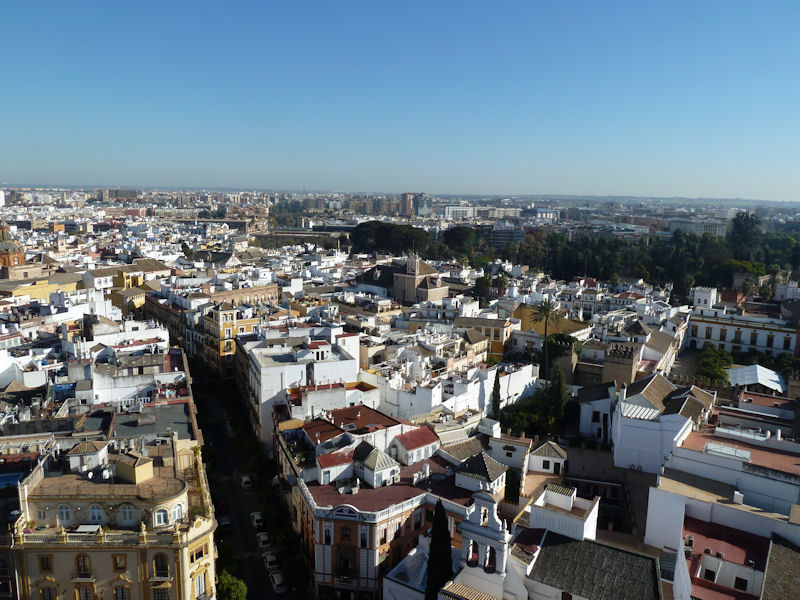
That's the Barrio de Santa Cruz, the old Judería or Jewish Quarter

Views from the Giralda

Additional views from the Giralda

Looking southwest over the Cathedral towards the river

The Courtyard of the Inedible Oranges

The Cathedral of the Bullfights: the La Maestranza bullfighting ring (and museum) was begun in 1760 and finished in 1880 (many wars intervened).

The Royal Alcázar -- originally the palace of the Moorish governors when Sevilla was the capital of Andalucia under the Almohad interlude in the 12th century. But in fact what we'll be strolling through tomorrow, with our little Panasonic Lumix point-and-shoot, was built on top of that by King Pedro the Cruel of Castile in the 1360s -- the worthy king (also known as "Pedro the Just") simply preferred the Mudéjar culture and art of the Moorish traditions, and most of his workmen were brought in from Granada.
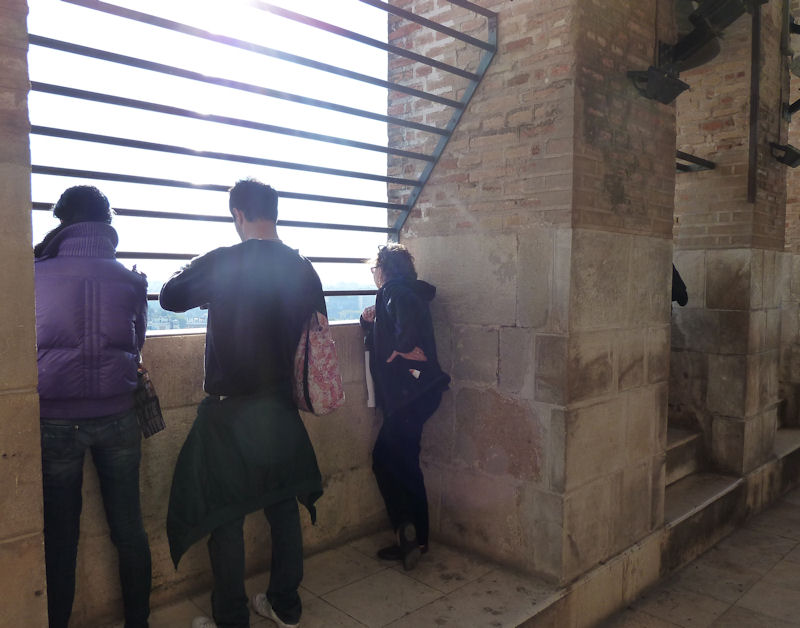
Kristin surveying Sevilla

Another muezzin's-eye view of the cathedral

The river Guadalquivir

As we're coming up on the hour, it may be time to get down out of here.

The Giralda tower from below -- the weathervane on the top, "El Giraldillo", is meant to symbolize "Faith" (constantly swiveling about with the winds).

The Giralda, built by the Almohads in the late 12th century

An antepenultimate view of the Cathedral

A penultimate view of the Cathedral

A last view of the Giralda and the Cathedral, for today anyway. We'll be back tomorrow for the Alcázar and whatever else gets in the way.

 Feedback
and suggestions are welcome if positive, resented if negative, Feedback
and suggestions are welcome if positive, resented if negative,  .
All rights reserved, all wrongs avenged. Posted 4 February 2012. .
All rights reserved, all wrongs avenged. Posted 4 February 2012.
|
 Dwight Peck's personal website
Dwight Peck's personal website





























































